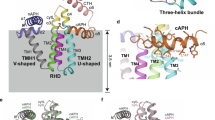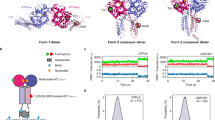Abstract
Establishment and maintenance of proper architecture is essential for endoplasmic reticulum (ER) function. Homotypic membrane fusion is required for ER biogenesis and maintenance, and has been shown to depend on GTP hydrolysis. Here we demonstrate that Drosophila Atlastin—the fly homologue of the mammalian GTPase atlastin 1 involved in hereditary spastic paraplegia—localizes on ER membranes and that its loss causes ER fragmentation. Drosophila Atlastin embedded in distinct membranes has the ability to form trans-oligomeric complexes and its overexpression induces enlargement of ER profiles, consistent with excessive fusion of ER membranes. In vitro experiments confirm that Atlastin autonomously drives membrane fusion in a GTP-dependent fashion. In contrast, GTPase-deficient Atlastin is inactive, unable to form trans-oligomeric complexes owing to failure to self-associate, and incapable of promoting fusion in vitro. These results demonstrate that Atlastin mediates membrane tethering and fusion and strongly suggest that it is the GTPase activity that is required for ER homotypic fusion.
This is a preview of subscription content, access via your institution
Access options
Subscribe to this journal
Receive 51 print issues and online access
$199.00 per year
only $3.90 per issue
Buy this article
- Purchase on Springer Link
- Instant access to full article PDF
Prices may be subject to local taxes which are calculated during checkout





Similar content being viewed by others
Change history
08 April 2010
An Erratum to this paper has been published: https://doi.org/10.1038/nature08886
References
Anderson, D. J. & Hetzer, M. W. Nuclear envelope formation by chromatin-mediated reorganization of the endoplasmic reticulum. Nature Cell Biol. 9, 1160–1166 (2007)
Dreier, L. & Rapoport, T. A. In vitro formation of the endoplasmic reticulum occurs independently of microtubules by a controlled fusion reaction. J. Cell Biol. 148, 883–898 (2000)
Vedrenne, C. & Hauri, H. P. Morphogenesis of the endoplasmic reticulum: beyond active membrane expansion. Traffic 7, 639–646 (2006)
Voeltz, G. K., Prinz, W. A., Shibata, Y., Rist, J. M. & Rapoport, T. A. A class of membrane proteins shaping the tubular endoplasmic reticulum. Cell 124, 573–586 (2006)
Zhao, X. et al. Mutations in a newly identified GTPase gene cause autosomal dominant hereditary spastic paraplegia. Nature Genet. 29, 326–331 (2001)
Sanderson, C. M. et al. Spastin and atlastin, two proteins mutated in autosomal-dominant hereditary spastic paraplegia, are binding partners. Hum. Mol. Genet. 15, 307–318 (2006)
Zhu, P. P. et al. Cellular localization, oligomerization, and membrane association of the hereditary spastic paraplegia 3A (SPG3A) protein atlastin. J. Biol. Chem. 278, 49063–49071 (2003)
Lee, Y. et al. Loss of spastic paraplegia gene atlastin induces age-dependent death of dopaminergic neurons in Drosophila . Neurobiol. Aging 29, 84–94 (2006)
Rismanchi, N., Soderblom, C., Stadler, J., Zhu, P. P. & Blackstone, C. Atlastin GTPases are required for Golgi apparatus and ER morphogenesis. Hum. Mol. Genet. 17, 1591–1604 (2008)
Wakefield, S. & Tear, G. The Drosophila reticulon, Rtnl-1, has multiple differentially expressed isoforms that are associated with a sub-compartment of the endoplasmic reticulum. Cell. Mol. Life Sci. 63, 2027–2038 (2006)
Snapp, E. L., Iida, T., Frescas, D., Lippincott-Schwartz, J. & Lilly, M. A. The fusome mediates intercellular endoplasmic reticulum connectivity in Drosophila ovarian cysts. Mol. Biol. Cell 15, 4512–4521 (2004)
Stanley, H., Botas, J. & Malhotra, V. The mechanism of Golgi segregation during mitosis is cell type-specific. Proc. Natl Acad. Sci. USA 94, 14467–14470 (1997)
Kondylis, V., Goulding, S. E., Dunne, J. C. & Rabouille, C. Biogenesis of Golgi stacks in imaginal discs of Drosophila melanogaster . Mol. Biol. Cell 12, 2308–2327 (2001)
Brand, A. H. & Perrimon, N. Targeted gene expression as a means of altering cell fates and generating dominant phenotypes. Development 118, 401–415 (1993)
Lippincott-Schwartz, J., Snapp, E. & Kenworthy, A. Studying protein dynamics in living cells. Nature Rev. Mol. Cell Biol. 2, 444–456 (2001)
Parkes, T. L. et al. Extension of Drosophila lifespan by overexpression of human SOD1 in motorneurons. Nature Genet. 19, 171–174 (1998)
Ward, T. H., Polishchuk, R. S., Caplan, S., Hirschberg, K. & Lippincott-Schwartz, J. Maintenance of Golgi structure and function depends on the integrity of ER export. J. Cell Biol. 155, 557–570 (2001)
Ishihara, N., Eura, Y. & Mihara, K. Mitofusin 1 and 2 play distinct roles in mitochondrial fusion reactions via GTPase activity. J. Cell Sci. 117, 6535–6546 (2004)
Rigaud, J. L. & Levy, D. Reconstitution of membrane proteins into liposomes. Methods Enzymol. 372, 65–86 (2003)
Scott, B. L. et al. Liposome fusion assay to monitor intracellular membrane fusion machines. Methods Enzymol. 372, 274–300 (2003)
Weber, T. et al. SNAREpins: minimal machinery for membrane fusion. Cell 92, 759–772 (1998)
Praefcke, G. J. & McMahon, H. T. The dynamin superfamily: universal membrane tubulation and fission molecules? Nature Rev. Mol. Cell Biol. 5, 133–147 (2004)
Borgese, N., Francolini, M. & Snapp, E. Endoplasmic reticulum architecture: structures in flux. Curr. Opin. Cell Biol. 18, 358–364 (2006)
Lee, S. & Cooley, L. Jagunal is required for reorganizing the endoplasmic reticulum during Drosophila oogenesis. J. Cell Biol. 176, 941–952 (2007)
Depienne, C., Stevanin, G., Brice, A. & Durr, A. Hereditary spastic paraplegias: an update. Curr. Opin. Neurol. 20, 674–680 (2007)
Lindholm, D., Wootz, H. & Korhonen, L. ER stress and neurodegenerative diseases. Cell Death Differ. 13, 385–392 (2006)
Polishchuk, R. S. & Mironov, A. A. Correlative video light/electron microscopy. Curr. Protoc. Cell Biol. Chapter 4, Unit–4.8 (2001)
Rigaud, J. L., Pitard, B. & Levy, D. Reconstitution of membrane proteins into liposomes: application to energy-transducing membrane proteins. Biochim. Biophys. Acta 1231, 223–246 (1995)
Giordano, E., Rendina, R., Peluso, I. & Furia, M. RNAi triggered by symmetrically transcribed transgenes in Drosophila melanogaster . Genetics 160, 637–648 (2002)
Schaub, J. R., Lu, X., Doneske, B., Shin, Y. K. & McNew, J. A. Hemifusion arrest by complexin is relieved by Ca2+-synaptotagmin I. Nature Struct. Mol. Biol. 13, 748–750 (2006)
Schaffner, W. & Weissmann, C. A rapid, sensitive, and specific method for the determination of protein in dilute solution. Anal. Biochem. 56, 502–514 (1973)
Acknowledgements
We thank J. Lippincott-Schwartz, R. Rikhy, M. Buszczak, M. Ramaswami and J. Kim for providing Drosophila strains, A. Gazziero for generating transgenic lines, and E. Giordano for the provision of the SympUAST vector. We thank M. G. Rossetto for support throughout the duration of the work, N. D’Elia for technical assistance, R. Polishchuck and the Telethon EM core facility, and W. Guo for help with EM analysis of negative stained Drosophila Atlastin proteoliposomes. This work was supported by grants from the National Institutes of Health (GM71832) and the G. Harold and Leila Mathers Charitable Foundation to J.A.M., and from Telethon-Italy, the Italian Ministry of Health and the Foundation Compagnia di San Paolo to A.D.
Author Contributions G.O. and D.P. contributed to the experimental design and carried out all Drosophila work. D.P. developed and performed the vesicle immunoprecipitation assay. J.T. performed HeLa cell transfection and immunoprecipitation experiments. S.L., T.J.M. and J.E.F. carried out liposome production, analyses and in vitro fusion. M.M. and A.E. conducted electron microscopy experiments. A.M. contributed to the experimental design and discussions. J.A.M. designed and supervised liposome production, analyses and in vitro fusion and contributed to writing the manuscript. A.D. conceived and designed the study, supervised Drosophila and cell culture experiments and wrote the manuscript.
Author information
Authors and Affiliations
Corresponding authors
Supplementary information
Supplementary Information
This file contains Supplementary Notes, Supplementary Figures S1-S16 with Legends and Supplementary References. (PDF 4738 kb)
Supplementary Movie 1
This movie shows a 3D reconstruction of confocal stacks from wild type muscle labelled with GFP-KDEL. (MPG 5698 kb)
Supplementary Movie 2
This movie shows a 3D reconstruction of confocal stacks from Datlastin mutant muscle labelled with GFP-KDEL. Loss of Datlastin results in a more sparse and fragmented ER network compared to wild type animal in movie 1. (MPG 5266 kb)
Rights and permissions
About this article
Cite this article
Orso, G., Pendin, D., Liu, S. et al. Homotypic fusion of ER membranes requires the dynamin-like GTPase Atlastin. Nature 460, 978–983 (2009). https://doi.org/10.1038/nature08280
Received:
Accepted:
Published:
Issue Date:
DOI: https://doi.org/10.1038/nature08280
This article is cited by
-
Dynamic changes in endoplasmic reticulum morphology and its contact with the plasma membrane in motor neurons in response to nerve injury
Cell and Tissue Research (2024)
-
Aurora kinase A-mediated phosphorylation triggers structural alteration of Rab1A to enhance ER complexity during mitosis
Nature Structural & Molecular Biology (2024)
-
Dynamics of CLIMP-63 S-acylation control ER morphology
Nature Communications (2023)
-
Identification of atlastin genetic modifiers in a model of hereditary spastic paraplegia in Drosophila
Human Genetics (2023)
-
3-Ketodihydrosphingosine reductase maintains ER homeostasis and unfolded protein response in leukemia
Leukemia (2022)
Comments
By submitting a comment you agree to abide by our Terms and Community Guidelines. If you find something abusive or that does not comply with our terms or guidelines please flag it as inappropriate.



